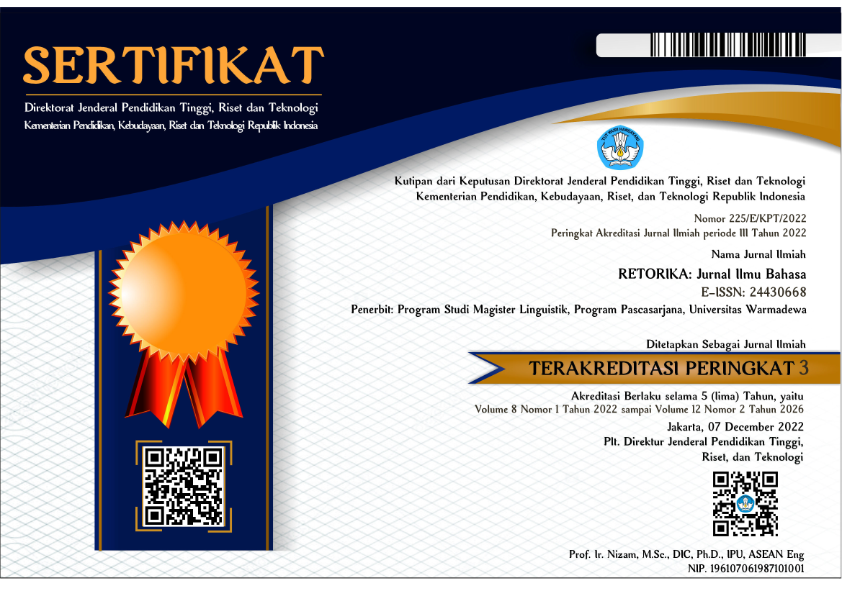Intra-Sentential and Intra-Lexical Code Mixing in Nessie Judge’s YouTube Video Entitled “Lagu Populer + Pesan Iblis Tersembunyiâ€
Abstract
As a linguistic phenomenon, code mixing is common to be identified in language users. Furthermore, YouTube as one of the online platforms has become an environment rich with the use of code mixing. Considering that YouTube might influence the language use in its audience, the following study aimed to identify the use of code-mixing presented by Indonesian content creator named Nessie Judge. Following the qualitative analysis research from Miles, Huberman, & Saldana (2014), the recent study identified the types of code mixing as presented by Hoffman namely, Intra-sentential code-mixing and Intra-lexical code-mixing. The present study identified the use of code mixing type intra-sentential and -lexical uttered by the speaker. From 114 utterances made by Nessie Judge in her video, code-mixing was identified in 86 utterances, where 53 utterances belong to intra-sentential code mixing and 13 utterances belonged to intra-lexical code mixing. The analysis revealed that the use of code mixing might be rooted in the speakers’ inability to find the equivalent words while discussing the video content. By looking at the number of the data percentage, intra-sentential code-mixing had more data than intra-lexical code-mixing meaning that the use of intra-sentential code-mixing was more common rather than intra-lexical code-mixing. It can be concluded because the speaker in the video inserts English words at the end of sentences or in the middle of sentences most of the time. The speaker on the video was clearly seen mixed Indonesian words with English words without changing the structure or context of the sentences.
References
BBC. (2014). “Language Otherâ€, (on-line).
Bhatia, T. K., & Ritchie, W. C. (2002). The Handbook of Bilingualism. Oxford: John Wiley and Sons†Ltd.
Chaer, A. (2003). Linguistik Umum. Jakarta: Rineka Cipta.
Hanafiah, R., Rantika, A., & Yusuf, M. (2018). The Levels of English-Arabic Code-Mixing in Islamic Boarding School Students’ Daily Conversation. Advances in Language and Literary Studies, 9(6), 78–81.
Hoffman, C. (1991). An Introduction to Bilingualism. New York:Roudledge Tailor and Francis Group.
Hornby, A. S. (2015). Oxford Advanced Learner’s Dictionary 9 Edition. London: Oxford University Press.
K, S. (2014). Backmasking. In: Language Myths, Mysteries and Magicâ€. Palgrave Macmillan,. London.
Kurniati, I. (2014). A Sociolinguistic Analysis of Code Mixing on Nine Summer Ten Autumns Novel by IwanSetiawan. Jakarta: UIN Syarif Hidayatullah Jakarta.
Moeliono, A. M., & Dardjowidjojo, S. (1997). Tata Bahasa Baku Bahasa Indonesia. Jakarta: Balai Pustaka.
Murtiningtyas, A. P. (2015). English Code-Mixing in Presidential Candidate Debates. Universita sSanata Dharma, Yogyakata.
Nababan, P. W. J. (1993). Sosiolinguistik Suatu Pengantar. Jakarta: Gramedia Pustaka Utama.
Saputro, A. (2013). The Analysis of Indonesian-English Code-Mixing Used in Marmot Merah Jambu Novel. Salatiga: State Islamic College of Salatiga.
Sosy. (2012). Reading on The Move Beginning, Middle, and End.
Sukrisna, A. (2019). An Analysis of Using Code Mixing on Atta Halilintar’s Video Youtube Channel. Lampung; RadenIntan State Islamic University.
Copyright (c) 2021 RETORIKA: Jurnal Ilmu Bahasa

This work is licensed under a Creative Commons Attribution-ShareAlike 4.0 International License.
This journal provides immediate open access to its content on the principle that making research freely available to the public supports a greater global exchange of knowledge.
All articles published Open Access will be immediately and permanently free for everyone to read and download. We are continuously working with our author communities to select the best choice of license options, currently being defined for this journal as follows: Creative Commons-Non Ceomercial-Attribution-ShareAlike (CC BY-NC-SA)
 Abstract viewed = 680 times
Abstract viewed = 680 times
 PDF downloaded = 1348 times
PDF downloaded = 1348 times

2.png)














